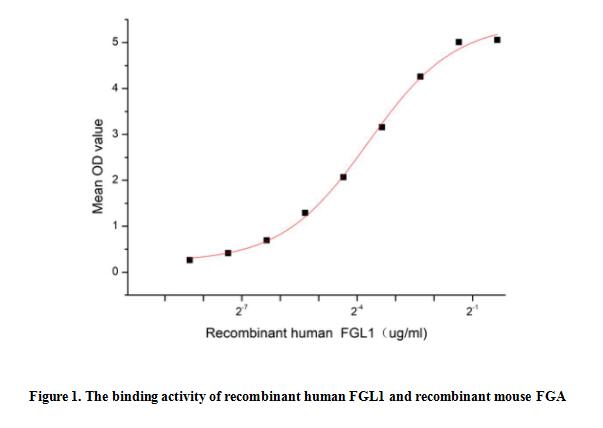Active Fibrinogen Like Protein 1 (FGL1) 

FGL-1; HFREP1; HP-041; LFIRE1; Hepassocin; Hepatocyte-derived fibrinogen-related protein 1; Liver fibrinogen-related protein 1
- UOM
- FOB US$ 240.00 US$ 600.00 US$ 1,200.00 US$ 3,600.00 US$ 9,000.00
- Quantity
Overview
Properties
- Product No.APD022Hu61
- Organism SpeciesHomo sapiens (Human) Same name, Different species.
- ApplicationsCell culture; Activity Assays.
Research use only - DownloadInstruction Manual
- CategoryHematology
- Buffer FormulationPBS, pH7.4, containing 5% Trehalose.
- Traits Freeze-dried powder, Purity > 95%
- Isoelectric Point5.4
Sign into your account
Share a new citation as an author
Upload your experimental result
Review

Contact us
Please fill in the blank.
Activity test

Fibrinogen Like Protein 1 (FGL1), also known as fibrinogen-related protein 1 or HFREP-1, is a member of the fibrinogen family. FGL1 has multiple biological functions, which plays an important role in intercellular signaling, immune regulation, cell adhesion and angiogenesis. In addition, the expression of FGL1 protein is also up-regulated in tumor tissues, such as lung, prostate, melanoma, colorectal, breast cancer, and brain tumors, suggesting that it may play an important role in the development and progression of these diseases. Fibrinogen Alpha Chain (FGA) has been identified as an interactor of FGL1, thus a functional binding ELISA assay was conducted to detect the interaction of recombinant human FGL1 and recombinant mouse FGA. Briefly, biotin-linked FGL1 were diluted serially in PBS, with 0.01% BSA (pH 7.4). Duplicate samples of 100 ul were then transferred to FGA-coated microtiter wells and incubated for 1h at 37℃. Wells were washed with PBST 3 times and incubation with Streptavidin-HRP for 30min, then wells were aspirated and washed 5 times. With the addition of substrate solution, wells were incubated 15-25 minutes at 37℃. Finally, add 50 µl stop solution to the wells and read at 450 nm immediately. The binding activity of recombinant human FGL1 and recombinant mouse FGA was shown in Figure 1, the EC50 for this effect is 0.07 ug/mL.
Usage
Reconstitute in 10mM PBS (pH7.4) to a concentration of 0.1-1.0 mg/mL. Do not vortex.
Storage
Avoid repeated freeze/thaw cycles. Store at 2-8°C for one month. Aliquot and store at -80°C for 12 months.
Stability
The thermal stability is described by the loss rate. The loss rate was determined by accelerated thermal degradation test, that is, incubate the protein at 37°C for 48h, and no obvious degradation and precipitation were observed. The loss rate is less than 5% within the expiration date under appropriate storage condition.
Increment services
-
 BCA Protein Quantification Kit
BCA Protein Quantification Kit
-
 Molecular Mass Marker for Protein
Molecular Mass Marker for Protein
-
 Monoclonal Antibody Customized Service
Monoclonal Antibody Customized Service
-
 Polyclonal Antibody Customized Service
Polyclonal Antibody Customized Service
-
 Protein Activity Test Experiment Service
Protein Activity Test Experiment Service
-
 Electrophoretic Mobility Shift Assay (EMSA) Experiment Service
Electrophoretic Mobility Shift Assay (EMSA) Experiment Service
-
 Buffer
Buffer
-
 Lentivirus Packaging Experiment Service
Lentivirus Packaging Experiment Service
-
 Adenovirus Packaging Experiment Service
Adenovirus Packaging Experiment Service
-
 Real Time PCR Experimental Service
Real Time PCR Experimental Service
-
 Spike RBD Protein (S-RBD)
Spike RBD Protein (S-RBD)
-
 Protein G
Protein G
-
 Protein A
Protein A
Citations
- The role of Hepassocin in the development of non-alcoholic fatty liver diseasePubmed: 23792031
- Serum hepassocin concentrations in diabetic patients with or without nonalcoholic fatty liver diseaseFuturemedicine:Source
- Compositions and Methods for Diagnosing Lung Cancery2016:0077095.html
- Obesity Drives STAT-1-Dependent NASH and STAT-3-Dependent HCCDoi: 10.1016/j.cell.2018.09.053
- Do different bariatric surgery procedures impact hepassocin plasma levels in patients with type 2 diabetes mellitus?
- Impacts of Different Modes of Bariatric Surgery on Plasma Levels of Hepassocin in Patients with Diabetes Mellitus







